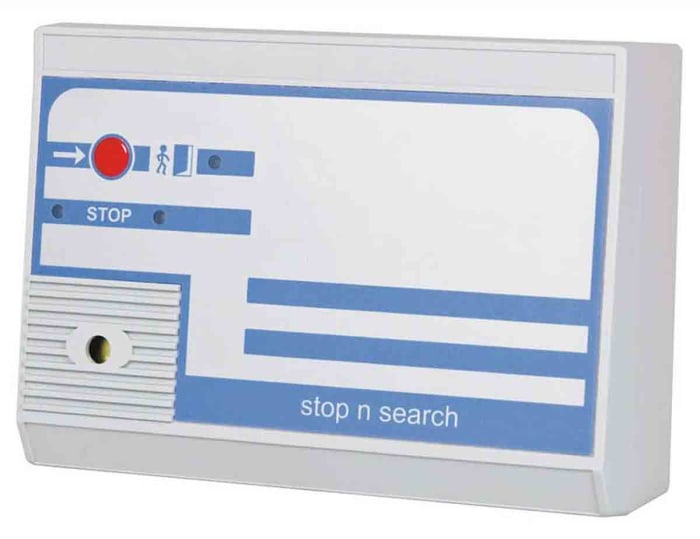Technical Document
Specifications
Brand
HoylesSystem Type
Random Person Selector
Series
Stop n Search
Unlocking Device
Button
Height
175 mm
Depth
60 mm
Width
125mm
Country of Origin
United Kingdom
Product details
Stop n Search TAG3
Stop n Search is invaluable to management and provides reassurance that if you are subjected to a search regime it is at least carried out randomly and that no one is being singled out for special treatment. The mains powered TAG3 can be used for comprehensive egress control using an external card reader, keypad or other triggering means if necessary. Electrical door retention and remote monitoring are catered for. Selection can be signalled to a remote point if required. The integral power supply is NOT sufficient to power electronic door locks. If desired the TAG3 can be powered from an external supply of 12 vdc.
The TAG 3 is a mains powered unit and can be used to control an exit door and signal to a remote equipment. Stop n Search can be used on leaving or entering premises where staff pilfering is suspected or the carrying of weapons or drugs may be a problem. The selection frequency is set up on installation but can be changed to suit changing circumstances. The selection frequency can be set as 2, 5, 10, 20, 30, 50, 70 or 90 percent. If for example a selection frequency of 30% is used then 30 in 100 people would be selected randomly. It is impossible to control the randomness or create a guessable pattern. The software generates a selection if the button is permanently pressed in order to deter users from trying to disable the system. A facility is incorporated to allow a no search condition if staff are not available to conduct a search but still give the impression that the random search regime is in use.
Audible bleep & LED indicator
Remote indication option
Adjustable selection frequency
Touch button or remote input
Relay output to enable an exit door to be kept locked on selection
Relay output for signalling selection to a remote point eg. a manager
A door contact or PIR input to activate the selection process
A card reader or keypad unit to activate the selection process
“No Select” facility that can secretly switch in if search staff are not available whilst still giving the impression that Stop n Search is still functioning
Reset keyswitch to permit passage after selection
Various modes of operation are possible including a fast moving mode where dwell times for door retainers would cause congestion
P.O.A.
1
P.O.A.
Stock information temporarily unavailable.
1
Stock information temporarily unavailable.
Technical Document
Specifications
Brand
HoylesSystem Type
Random Person Selector
Series
Stop n Search
Unlocking Device
Button
Height
175 mm
Depth
60 mm
Width
125mm
Country of Origin
United Kingdom
Product details
Stop n Search TAG3
Stop n Search is invaluable to management and provides reassurance that if you are subjected to a search regime it is at least carried out randomly and that no one is being singled out for special treatment. The mains powered TAG3 can be used for comprehensive egress control using an external card reader, keypad or other triggering means if necessary. Electrical door retention and remote monitoring are catered for. Selection can be signalled to a remote point if required. The integral power supply is NOT sufficient to power electronic door locks. If desired the TAG3 can be powered from an external supply of 12 vdc.
The TAG 3 is a mains powered unit and can be used to control an exit door and signal to a remote equipment. Stop n Search can be used on leaving or entering premises where staff pilfering is suspected or the carrying of weapons or drugs may be a problem. The selection frequency is set up on installation but can be changed to suit changing circumstances. The selection frequency can be set as 2, 5, 10, 20, 30, 50, 70 or 90 percent. If for example a selection frequency of 30% is used then 30 in 100 people would be selected randomly. It is impossible to control the randomness or create a guessable pattern. The software generates a selection if the button is permanently pressed in order to deter users from trying to disable the system. A facility is incorporated to allow a no search condition if staff are not available to conduct a search but still give the impression that the random search regime is in use.
Audible bleep & LED indicator
Remote indication option
Adjustable selection frequency
Touch button or remote input
Relay output to enable an exit door to be kept locked on selection
Relay output for signalling selection to a remote point eg. a manager
A door contact or PIR input to activate the selection process
A card reader or keypad unit to activate the selection process
“No Select” facility that can secretly switch in if search staff are not available whilst still giving the impression that Stop n Search is still functioning
Reset keyswitch to permit passage after selection
Various modes of operation are possible including a fast moving mode where dwell times for door retainers would cause congestion

